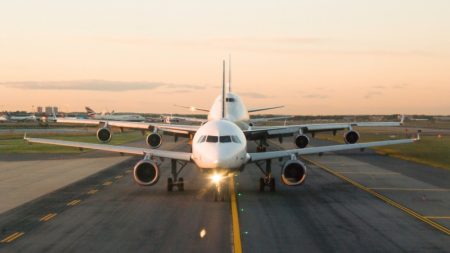July 5, 2017 – A new phrase entered common use in the last month – “weight restriction days.” But it might as well be called “wait restriction days” because that’s what airlines are going to face as climate change heats up the atmosphere even more.
What does “weight restriction days” mean?
Airplanes get their lift from pushing against air molecules and as they speed up Bernoulli’s Principle comes into effect as the wings gain lift. But hotter air is less dense, that is there are fewer molecules per square centimeter, than cooler air. That means the wings on hot days have to less to push against to gain lift. To compensate airplanes on takeoff have to gain higher speed. That means longer runways at commercial airports are needed for normal daily operations.
What happened in the last month to put “weight restriction days” on the radar?
In Phoenix, Arizona, record high temperatures were set in the third week of June. Daily daytime highs reached over 46 Celsius (115 Fahrenheit) for three straight days. At Sky Harbor Airport, flights were canceled. On one day the total was 50 flights. On another, American Airlines alone canceled 40 of its American Eagle commuter flights because its airplane, a Bombardier CRJ, imposes restrictions on operations when temperatures reach 48 Celsius (118 Fahrenheit). American Airlines told passengers it had to ground these flights because of the heat wave and waived rebooking fees. Larger jets at Sky Harbor were unaffected including Boeing and Airbus fleets. Why? Because their operational limit is 52 to 53 Celsius (126 to 127 Fahrenheit).
Has this happened to Phoenix before?
Yes. In 1990 temperatures hit 50 Celsius (122 Fahrenheit) leading to the grounding of many flights.
Will it happen again?
Undoubtedly.
Why?
Because warmer, thinner air affects airflow over the wings. Less airflow means less thrust. Climate change means temperatures in Phoenix and in other locations around the world are only going to get warmer. That means on hot days the airplanes that do fly will need to carry smaller payloads, which means fewer passengers or less cargo, which will also mean less revenue per flight and an overall negative impact on the airline industry.
The physics of all of this involves the following parameters:
- air pressure
- temperature
- humidity
- wind speed
- aircraft weight
- runway length
To calculate the margin for a safe flight you combine all these parameters. I did a little bit of the calculation in my head and soon found it a bit mindboggling.
For example, figuring out Phoenix’ average air pressure at 340 meters (1,117 feet) above sea level requires the knowledge of what standard air pressure is at sea level. That number is 101.325 kiloPascals or if you like, 1 atmosphere, or 14.7 pounds per square inch, or 29.9 inches in a mercury barometer. As elevation increases air pressure drops. So at 300 meters, 40 meters below Phoenix’ average elevation, air pressure is approximately 97 kiloPascals, a half-pound per square inch less, and an inch lower on the mercury scale. That means fewer molecules for the airplane to push against which means more drag.
Now add the calculations for temperature, relative humidity, and wind speed. These latter three can further reduce air pressure, so as the airplane picks up speed going down the runway its mass and weight exerting pressure on the less dense air affect lift negatively. Needless to say, getting any of these calculations wrong and an airplane will not fly.
In the case of Phoenix in this last month, conditions produced a perfect storm of data, too hot, too dry, and too little air pressure. The result, American Airlines and other operators recognized the danger and canceled flights. For Phoenix, the 13th largest city in the United States, heat, drought, and winds are all expected to increase with global warming.
So dodging the heat will become the new airline operations’ strategy. In the hot desert locale, June, July, and August daytime temperatures are expected to reach between 50 to 55 Celsius. The airplanes flying today, in the heat of the day, will not be able to takeoff safely. That means people going from Phoenix by air will find themselves adapting to a flight schedule of early and late hours when conditions will be much safer.


















